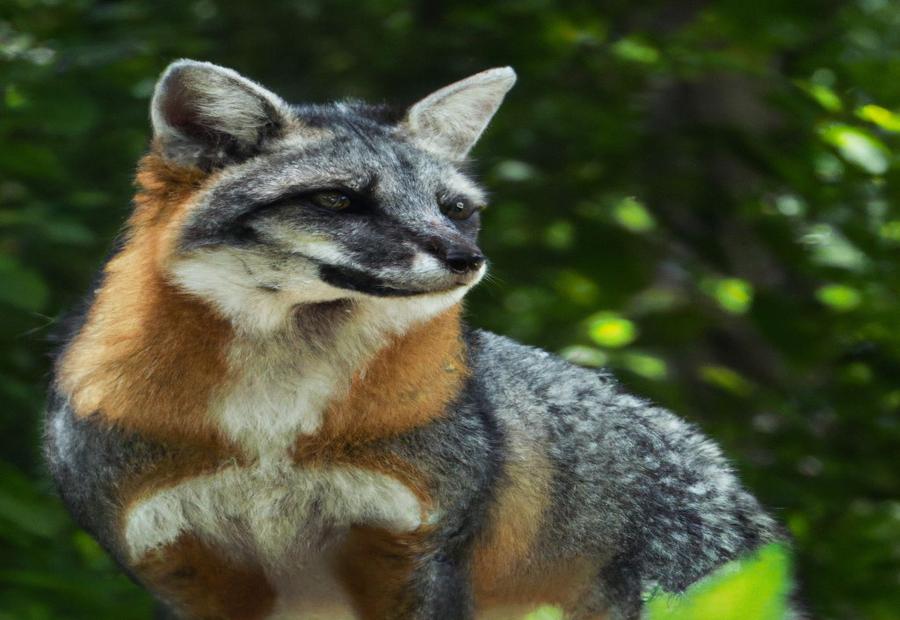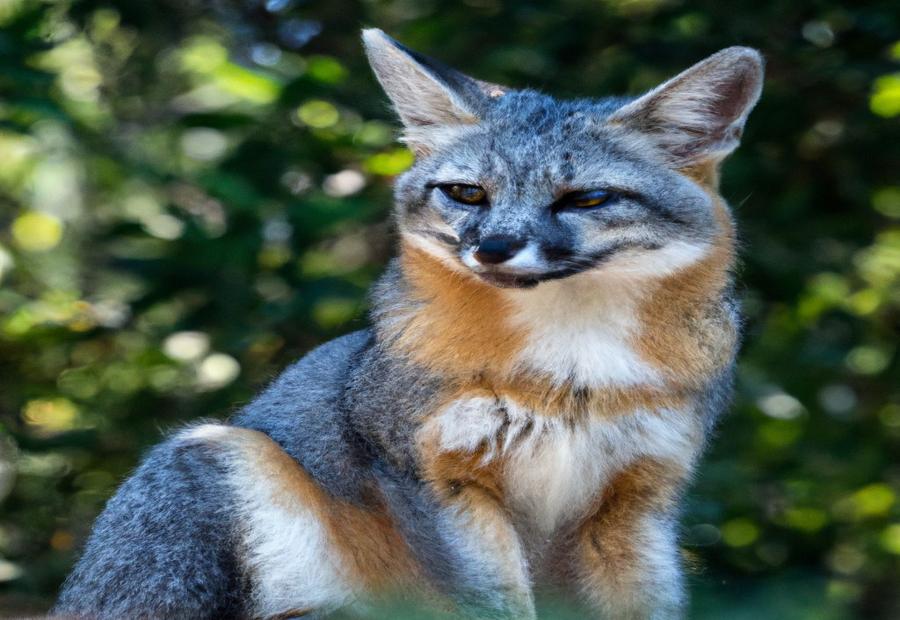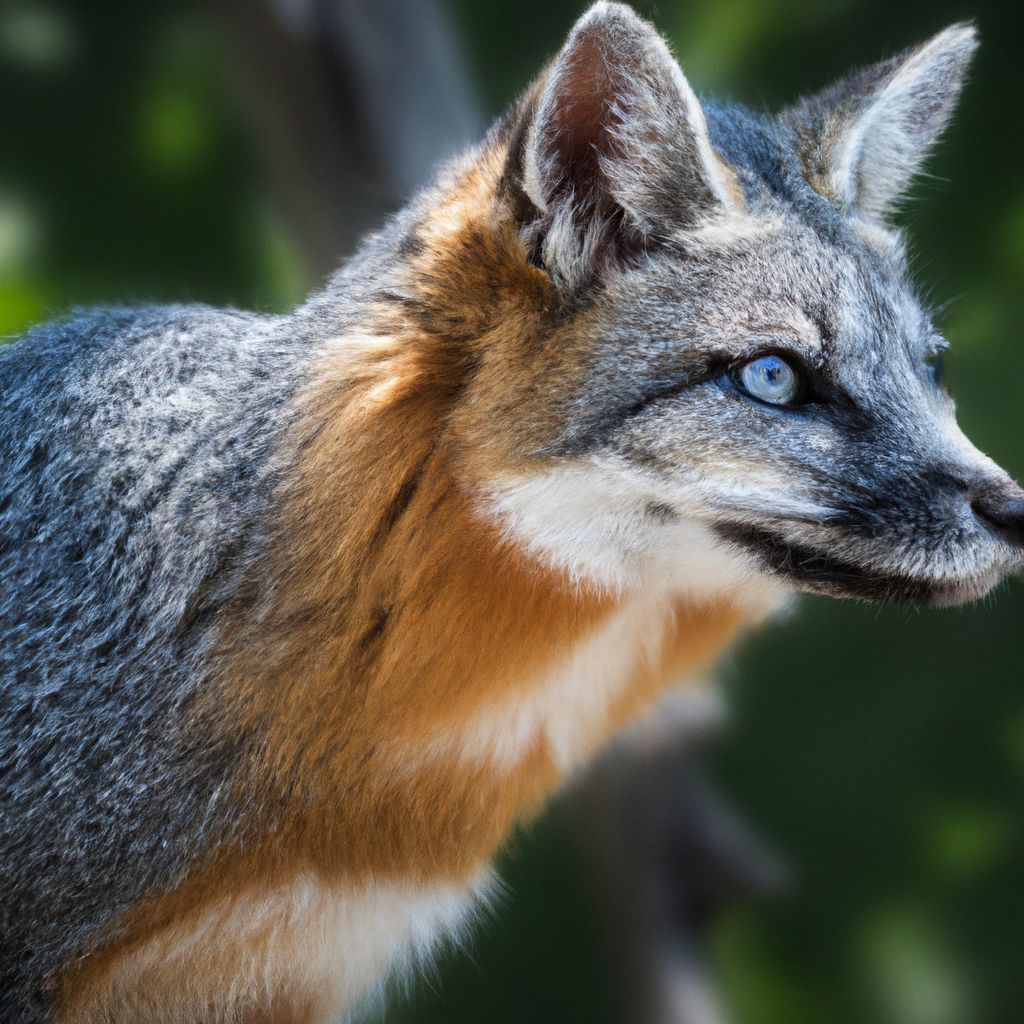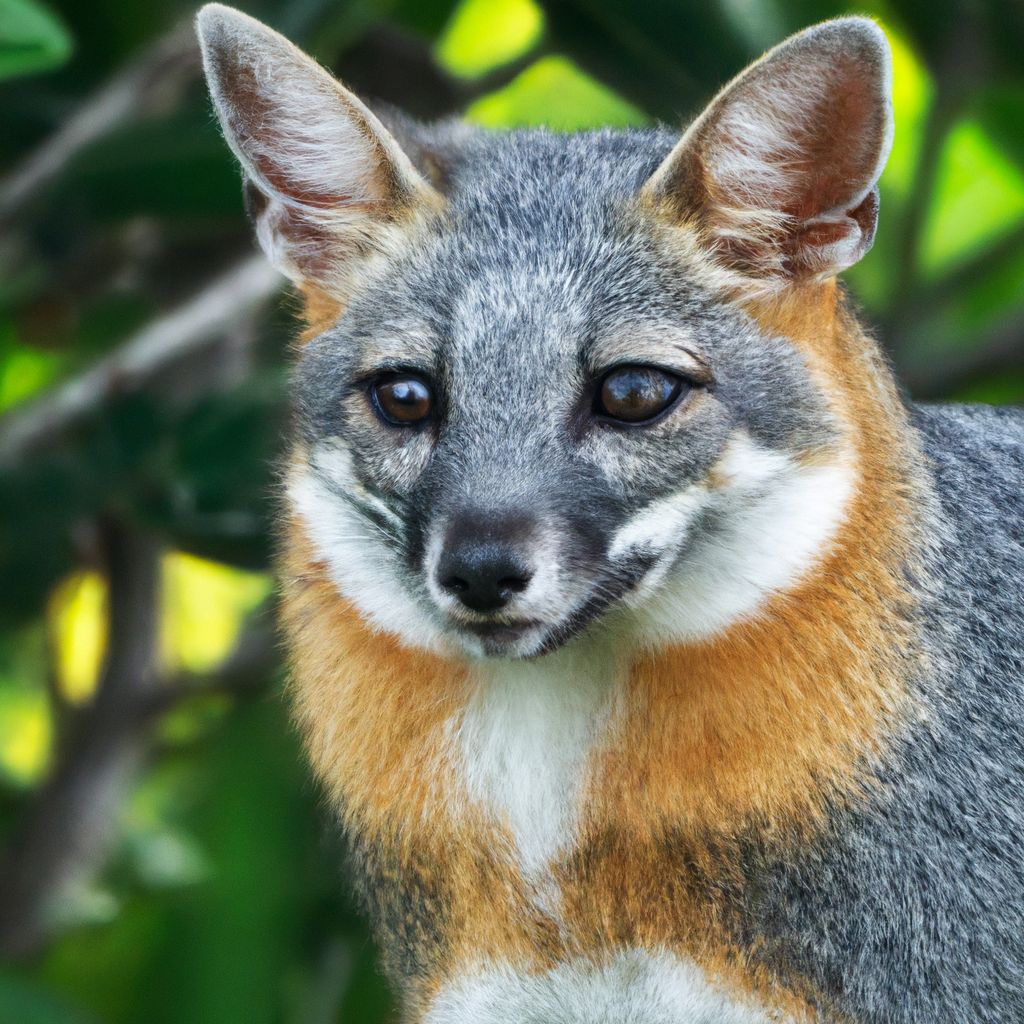The Gray Fox, also known as Urocyon cinereoargenteus, is a fascinating species of fox that has demonstrated remarkable adaptability to various habitats. This article takes a detailed look at the gray fox’s physical characteristics, behavior, social structure, hunting strategies, and factors influencing its adaptation to different habitats. An examination of its hunting and feeding patterns, communication and interactions, as well as its adaptation to forests and woodlands, grasslands and savannahs, and deserts and arid regions will be explored. we will explore the gray fox’s hunting strategies in these different habitats and the factors that influence its adaptation, such as diet variation and competition with other carnivores. Finally, we will discuss the conservation concerns surrounding the gray fox and the efforts being made to preserve this remarkable species.
Contents
- 1 Key takeaway:
- 2 The Physical Characteristics of the Gray Fox
- 3 Behavior and Social Structure of the Gray Fox
- 4 The Gray Fox’s Adaptation to Various Habitats
- 5 The Gray Fox’s Hunting Strategies in Different Habitats
- 6 Factors Influencing the Gray Fox’s Adaptation to Changing Habitats
- 7 Conservation Concerns for the Gray Fox
- 8 Frequently Asked Questions
Key takeaway:
- The Gray Fox’s adaptation to different habitats: The Gray Fox has successfully adapted to various habitats including forests, woodlands, grasslands, savannahs, and even deserts. This adaptability allows them to thrive and survive in diverse environments.
- Diverse hunting strategies in different habitats: The Gray Fox utilizes different hunting techniques depending on the habitat it inhabits. From stalking and pouncing on prey in forested areas to employing more open field strategies in grasslands, the Gray Fox demonstrates remarkable versatility.
- Influencing factors for adaptation: Diet variation and competition with other carnivores play a significant role in the Gray Fox’s ability to adapt to changing habitats. These factors shape their behavior and hunting patterns, ultimately affecting their survival in different environments.
The Physical Characteristics of the Gray Fox
The Physical Characteristics of the Gray Fox
The Gray Fox possesses fur, size, and body structure that contribute to its unique physical characteristics.
- Fur: The Gray Fox has a beautiful, multi-colored coat that includes shades of gray, brown, black, and red. This helps it blend into its surroundings and provides effective camouflage.
- Size: On average, the Gray Fox measures 32 to 45 inches in length, with the tail comprising about a third of its total length. It weighs between 7 and 14 pounds, making it smaller than the Red Fox.
- Body structure: The Gray Fox has a slender body with a bushy tail. Although its legs are relatively short, it possesses strong and agile movements, enabling it to navigate different terrains with ease.
One day, while hiking in the woods, I had an encounter that exemplified the physical characteristics of the Gray Fox. I stumbled upon a small clearing and silently observed from a distance. Suddenly, a Gray Fox emerged from the thick underbrush, its fur glistening as it gracefully moved through the tall grass. I was astounded by how well its coloration matched the surrounding environment, rendering it almost invisible. The fox’s dexterity was evident as it effortlessly leaped over fallen logs and boulders, showcasing its agility. Its slim body and bushy tail provided impeccable balance as it maneuvered through the forest. It was a truly remarkable sight, showcasing the extraordinary physical characteristics of this fox species.
Behavior and Social Structure of the Gray Fox
The behavior and social structure of the gray fox reveal fascinating insights into this elusive creature. Discover the intricacies of their hunting and feeding patterns, as well as their unique modes of communication and interactions. From their stealthy hunting techniques to the complex dynamics within their social groups, the gray foxes never fail to captivate with their exceptional adaptations to different habitats. Get ready to delve into the remarkable world of these elusive canids.
Hunting and Feeding Patterns
Hunting and Feeding Patterns
Grey foxes exhibit distinctive hunting and feeding patterns. While they are typically solitary hunters, they may occasionally team up and hunt as pairs or small groups. Utilizing their acute sense of hearing and smell, these foxes locate their prey, which includes small mammals, birds, reptiles, and insects. Their hunting tactics involve stealthily stalking their prey and then swiftly pouncing to catch them off guard. With their exceptional climbing abilities, gray foxes can even pursue prey in trees. Additionally, they are proficient at digging to uncover small mammals that seek refuge underground. The most active periods for gray foxes coincide with the dawn and dusk hours when their prey is also active. They possess the ability to consume substantial amounts of food in one sitting and are capable of storing excess food in their dens or creating caches for later consumption.
In terms of feeding, gray foxes display an opportunistic feeding pattern and can scavenge carrion when necessary. Their diet encompasses various small mammals such as rodents, rabbits, and squirrels, as well as birds, eggs, reptiles, amphibians, and insects. This adaptable approach allows gray foxes to thrive in different environments and sustain themselves by exploiting a wide array of food sources.
Communication and Interactions
Communication and interactions play a vital role in the lives of gray foxes. These clever creatures rely on vocalizations, body language, and interactions with other animals to effectively communicate and navigate their surroundings.
Gray foxes utilize various vocalizations, including barks, screams, and howls, to convey important messages to their fellow foxes. These sounds serve multiple purposes, such as alerting others to potential dangers, marking their territories, or signaling potential mates.
Body language also plays a significant role in gray fox communication. They skillfully employ their tails, ears, and facial expressions to express their emotions and intentions. For instance, a raised tail indicates aggression, whereas a lowered tail signifies submission. To learn more about the denning behavior of the gray fox, click here.
Not only do gray foxes interact within their own species, but they also engage with other animals in their habitat, such as birds, rabbits, and rodents. These interactions can span from predator-prey relationships to situations where the foxes benefit from the presence of other animals.
When it comes to interactions with humans, gray foxes tend to avoid direct contact. However, on occasion, they may venture into residential areas in search of food or shelter. It is crucial for humans to respect the communication and vocalizations of the gray fox and refrain from disrupting their natural behaviors.
Understanding the communication and interactions of gray foxes is of paramount importance in studying their behavior and social structure. By closely observing these fascinating creatures, we can gain valuable insights into their adaptation to various habitats and implement conservation measures to safeguard their populations.
The Gray Fox’s Adaptation to Various Habitats

Photo Credits: Foxauthority.Com by Larry Martin
Native to North and Central America, the Gray Fox proves its incredible adaptability across a range of habitats. Join us as we uncover the secrets of its survival in diverse environments. From dense forests and woodlands to vast grasslands and savannahs, and even harsh deserts and arid regions, the Gray Fox demonstrates remarkable resilience. Discover how this elusive creature conquers each habitat, harnessing unique strategies for survival. Let’s embark on a fascinating journey into the world of the Gray Fox and its ability to conquer varied terrains.
Forests and Woodlands
Forests and woodlands are crucial for the survival of the gray fox. They play a vital role by providing abundant food sources, camouflage and protection, vertical escape routes, nesting and denning sites, and navigational abilities.
Firstly, forests and woodlands offer a diverse range of prey for the gray fox, including small mammals like mice, voles, and rabbits. The dense vegetation in these areas also acts as cover, allowing the fox to stealthily approach its prey.
Secondly, the gray fox’s fur coloration blends seamlessly with the dense foliage, providing effective camouflage against predators and humans. Additionally, the vegetation in forests and woodlands offers protection from harsh weather conditions and extreme temperatures.
The presence of trees and branches in forested areas provides vertical escape routes for the gray fox. In case of danger, the fox can quickly climb trees and stay out of reach from predators.
Forests and woodlands also offer suitable locations for the gray fox’s dens or natural shelter. Fallen trees and hollow logs serve as safe spaces for breeding, raising young, and protection from larger predators.
Gray foxes have adapted to the complex terrain of forests and woodlands, allowing them to navigate efficiently. Their agility and climbing skills enable them to maneuver obstacles and find efficient pathways for hunting or exploration.
Understanding the significance of forests and woodlands in the fascinating world of the Gray Fox: A 2023 Perspective‘s adaptation is crucial for guiding conservation efforts and preserving these important ecosystems.
Grasslands and Savannahs
When it comes to the gray fox’s adaptation, it is important to understand how it thrives in grasslands and savannahs. Here are some key points:
– Food sources: The gray fox primarily preys on small mammals like rabbits, mice, and ground squirrels in grasslands and savannahs. These habitats provide ample hunting opportunities.
– Camouflage: The gray fox’s coat color ranges from gray to red, allowing it to blend with the surrounding vegetation in grasslands and savannahs. This helps it hide from predators and sneak up on prey.
– Shelter: Despite fewer natural hiding spots in grasslands and savannahs, the gray fox utilizes available cover such as tall grasses, shrubs, or rock formations for shelter and protection.
– Mating and raising young: Grasslands and savannahs provide ideal conditions for the gray fox to establish territories and mate. The open spaces facilitate communication between mates and the rearing of young in hidden dens.
– Adaptations: The gray fox has specialized adaptations to thrive in grasslands and savannahs. Its slender body and agility enable it to navigate through tall grasses and effectively chase down prey. It also possesses keen senses, including excellent hearing and a keen sense of smell, which aid in hunting.
Fun Fact: The gray fox is the only canid capable of climbing trees. This unique ability allows it to escape predators and find food in trees, making it a highly adaptable and fascinating species in different habitats.
Deserts and Arid Regions
Deserts and arid regions pose unique challenges for the gray fox, but this adaptable species has developed strategies to thrive in these harsh environments.
1. Water conservation: In deserts and arid regions, water is scarce. The gray fox obtains most of its water from food, reducing its dependency on external water sources. This adaptation allows it to survive in areas with limited access to water.
2. Nocturnal behavior: In desert and arid regions, the gray fox is primarily nocturnal to avoid the scorching heat of the day. It is most active during twilight and nighttime when the temperature is more tolerable.
3. Burrowing habits: The gray fox uses its strong digging abilities to create burrows or find existing ones as shelter during the day. These burrows protect it from extreme temperatures and predators, providing a safe place to rest.
4. Dietary flexibility: Food resources can be scarce in deserts and arid regions. The gray fox has a varied diet, consuming small mammals, insects, birds, fruits, and even cacti. This flexibility in food choices enables it to adapt to the limited availability of resources in arid environments.
5. Camouflage: The sandy and rocky landscapes of deserts and arid regions require effective camouflage. The gray fox’s fur coloration, with its mix of grays, browns, and reds, blends well with the surroundings, providing camouflage and enhancing its chances of survival.
Suggestions for exploring deserts and arid regions:
– If planning a trip to a desert or arid region, observe the local wildlife and learn about the fascinating adaptations of the gray fox.
– Learn about the various plants and animals that have unique ways of surviving in extreme environments.
– Take precautions to stay hydrated and protected from the harsh sun, and respect the fragile desert ecosystem.
By understanding the gray fox’s adaptations to deserts and arid regions, we can appreciate its incredible ability to thrive in some of the harshest environments on Earth.
The Gray Fox’s Hunting Strategies in Different Habitats
The Gray Fox is a true master of adaptation when it comes to hunting in different habitats. From dense forested areas to open grasslands and even arid environments, this cunning predator employs a variety of unique hunting strategies. Join us as we uncover the secrets behind the Gray Fox’s hunting techniques in forested areas, its clever strategies in open grasslands, and the remarkable adaptations it employs to survive in arid environments. Prepare to be amazed by the versatility and ingenuity of this stealthy hunter!
Hunting Techniques in Forested Areas
Hunting Techniques in Forested Areas
When hunting in forests, the gray fox uses various strategies to catch its prey. These include:
– Stalking: The gray fox silently moves through the forest undergrowth, using camouflage and agility to get close to its prey.
– Ambushing: It lies in wait near game trails or feeding areas, relying on patience and stealth for a successful ambush.
– Pouncing: The gray fox swiftly pounces on its prey, using its powerful hind legs to surprise and catch it off guard.
– Tree climbing: Unlike other canids, the gray fox is an excellent climber, using its semi-retractable claws to climb trees for a better vantage point or to escape predators.
– Foraging: The gray fox also opportunistically searches for food in forested areas, including small mammals, birds, reptiles, amphibians, fruits, and berries on the forest floor.
These hunting techniques allow the gray fox to thrive in forests by using its agility, stealth, and adaptability to secure prey and survive.
Hunting Strategies in Open Grasslands
Hunting Strategies in Open Grasslands
In open grasslands, the gray fox uses specific hunting strategies to capture prey. Here are key hunting strategies employed by the gray fox:
- Ambush: Gray foxes blend into the grassy surroundings and patiently wait for prey. They use their hearing and smell to detect small mammals, birds, or reptiles.
- Pouncing: When prey is close, gray foxes use their hind legs to pounce, surprising and immobilizing their target. Their reflexes and agility enable successful captures in these environments.
- Stalking: The gray fox stealthily creeps towards the target, keeping low to the ground. This allows the fox to remain undetected until it can launch a swift attack.
- Chasing: Sometimes, when prey tries to flee, the gray fox engages in short bursts of high-speed pursuit, using its speed and endurance to chase it down.
These hunting strategies showcase the gray fox’s adaptability and resourcefulness in capturing prey in different habitats. By using a combination of ambush, pouncing, stalking, and chasing techniques, the gray fox maximizes its chances of obtaining food in open grassland environments.
Adaptations for Surviving in Arid Environments
The Gray Fox has developed various adaptations for surviving in arid environments. It effectively conserves water through its highly efficient kidneys, thereby minimizing water loss. Additionally, it obtains moisture from its diet, reducing the reliance on external water sources.
The Fox’s fur is specialized to provide insulation against extreme temperatures and protection from the sun and cold. Moreover, it has become highly skilled in hunting small mammals, thus ensuring a sustainable food source. These remarkable adaptations exemplify the Fox’s ability to thrive in diverse habitats and overcome the challenges posed by arid regions.
Factors Influencing the Gray Fox’s Adaptation to Changing Habitats
In the ever-changing world of habitats, the Gray Fox has managed to adapt and thrive. Join me as we explore the factors that influence the Gray Fox‘s remarkable ability to adapt to different environments. From its varied diet choices to the challenges it faces in competing with other carnivores, we’ll uncover the secrets behind this enigmatic creature’s successful survival strategies. Prepare to be amazed by the cunning and resilience of the Gray Fox as we delve into its fascinating world of adaptation.
Diet Variation
Diet variation plays a crucial role in the gray fox‘s adaptation to different habitats. When living in forested areas, the gray fox primarily relies on small mammals such as rodents, rabbits, and squirrels for sustenance. However, in open grasslands, its diet shifts to include a greater proportion of birds, insects, and reptiles. In arid environments where food is scarce, the gray fox demonstrates its adaptability by consuming fruits, berries, and carrion. This remarkable ability to adjust its diet enables the gray fox to not only survive but also thrive in a wide range of ecosystems, even when faced with changes in its environment or competition from other carnivores. Incorporating various food items into its diet allows the gray fox to maintain optimal health and overall well-being in diverse habitats.
Competition with Other Carnivores
Competition with other carnivores is a crucial aspect of the Gray Fox’s adaptation to various habitats. The Gray Fox competes with predators such as coyotes, bobcats, wolves, cougars, and kit foxes for food resources. This competition occurs in forested areas, where they compete with coyotes and bobcats for similar prey species. In open grasslands, the Gray Fox faces competition from larger predators like wolves and cougars. In arid environments, competition becomes even more significant due to the scarcity of food resources. To cope with this competition, the Gray Fox may adjust its hunting habits by hunting at different times or targeting different prey species.
Conservation Concerns for the Gray Fox

Photo Credits: Foxauthority.Com by Vincent Allen
Conserving the gray fox population is crucial for biodiversity and ecosystem balance. It is important to address the key conservation concerns for gray foxes. These concerns include:
-
Habitat Loss: Gray foxes are greatly affected by urbanization, deforestation, and agricultural expansion. As their natural habitats shrink, their ability to find food and shelter is compromised.
-
Fragmentation: The fragmentation of gray fox habitats due to roads, fences, and development leads to isolated populations and reduced genetic diversity. This lack of genetic diversity makes populations more susceptible to diseases and other threats.
-
Human-Wildlife Conflict: Gray foxes may come into conflict with humans when they raid poultry or fruit crops. This can result in negative attitudes towards the species and even retaliatory actions.
-
Poaching: The illegal hunting and trapping of gray foxes for fur or sport remains a significant concern. This activity not only impacts local populations but also disrupts natural ecological processes.
-
Climate Change: Climate change has adverse effects on the availability of food and water sources for gray foxes. Changes in temperature and precipitation patterns disrupt their natural foraging behaviors and increase competition for limited resources.
To address these conservation concerns, it is crucial to focus efforts on preserving and restoring gray fox habitats, implementing sustainable land-use practices, raising awareness about coexistence with wildlife, and strengthening legal protection against poaching. By promoting coexistence and conservation, we safeguard the gray fox population for future generations.
Pro-tip: You can contribute to gray fox conservation by planting native vegetation in your yard. This will create habitat and provide food sources for gray foxes and other wildlife.
Frequently Asked Questions
1. What are the identifying features of the Gray Fox?
The Gray Fox has a mix of white, red, gray, and black fur. It has a distinct black stripe on the top surface of its tail. This medium-sized fox has long bodies and fairly short legs.
2. How does the Gray Fox adapt to different habitats?
The Gray Fox is a versatile species that can adapt to various habitats such as wooded areas, rocky canyons, open desert, grasslands, and even urban and suburban environments. It can make its dens in caves, mine shafts, boulder piles, hollow logs, or abandoned burrows.
3. Can the Gray Fox escape from predators?
Yes, the Gray Fox has a unique adaptation to escape from predators. It is the only member of the dog family that can climb trees. It has strong, hooked claws and rotating wrists, which allow it to climb up trees. However, it can be risky for them to climb down.
4. What is the life cycle of the Gray Fox?
The Gray Fox mates in February or March, and the gestation period lasts about 52 days. They give birth to 3 to 7 kits in April or May. The young open their eyes at 10 days old and start venturing out of the den after about 4 weeks. They are usually weaned at 10 weeks and remain with their family until late fall.
5. Where is the Gray Fox commonly found?
The Gray Fox can be found from southern Canada to most of the United States, Mexico, central America, and parts of South America. It prefers low elevations and is commonly found in wooded areas, rocky canyons, grasslands, and open desert. It used to be the most common fox in the eastern United States.
6. What is the diet of the Gray Fox?
The Gray Fox is an omnivorous mammal that eats a wide variety of foods including small mammals, eggs, fruit, birds, insects, nuts, berries, and lizards. It is even known to raid garbage cans for food. Its favorite meals are small mammals and cotton-tail rabbits.


